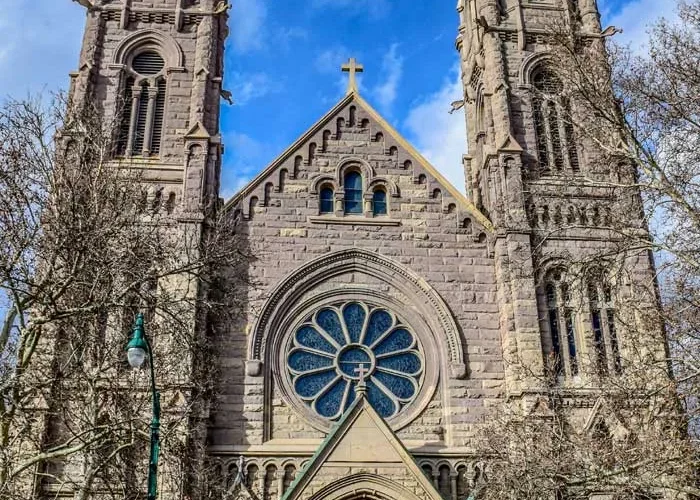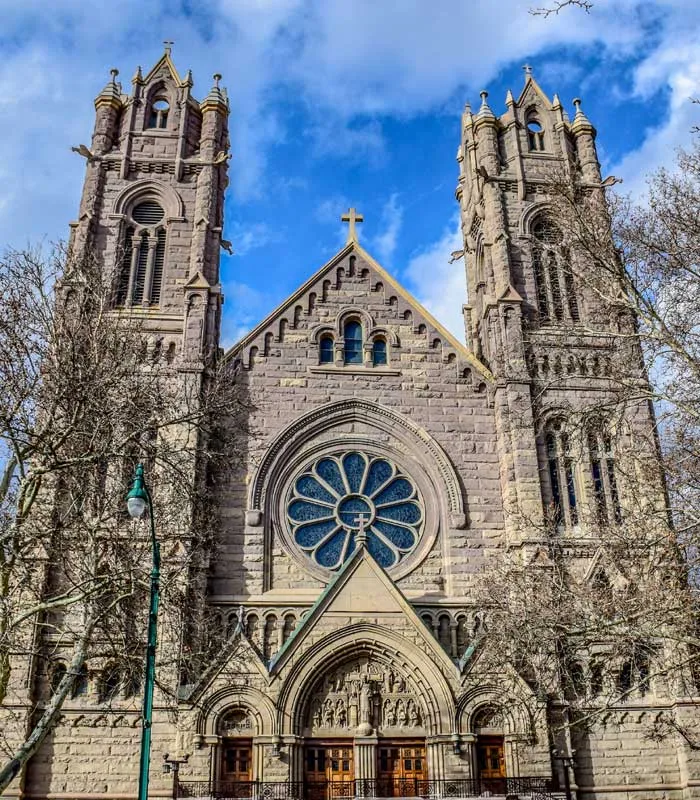
Introduction
The Cathedral of the Madeleine is a Roman Catholic Church in Salt Lake City, Utah, United States. It was completed in 1909 and currently serves as the cathedral, or mother church, of the Diocese of Salt Lake City. It is the only cathedral in the U.S. under the patronage of St. Mary Magdalene.
Led by The Right Reverend Lawrence Scanlan, Salt Lake City’s first bishop, construction on the Cathedral on South Temple began in 1899 and was completed in 1909. Architects Carl Neuhausen and Bernard Mecklenburg combined a predominantly Romanesque exterior with a Gothic interior on the structure.
A $9.7 million renovation begun in 1991 substantially enhanced and strengthened the structure. The renewed building was rededicated on February 21, 1993, and the cathedral is listed on both the Utah and national registers of historic places.
History of Cathedral of the Madeleine, Salt Lake City
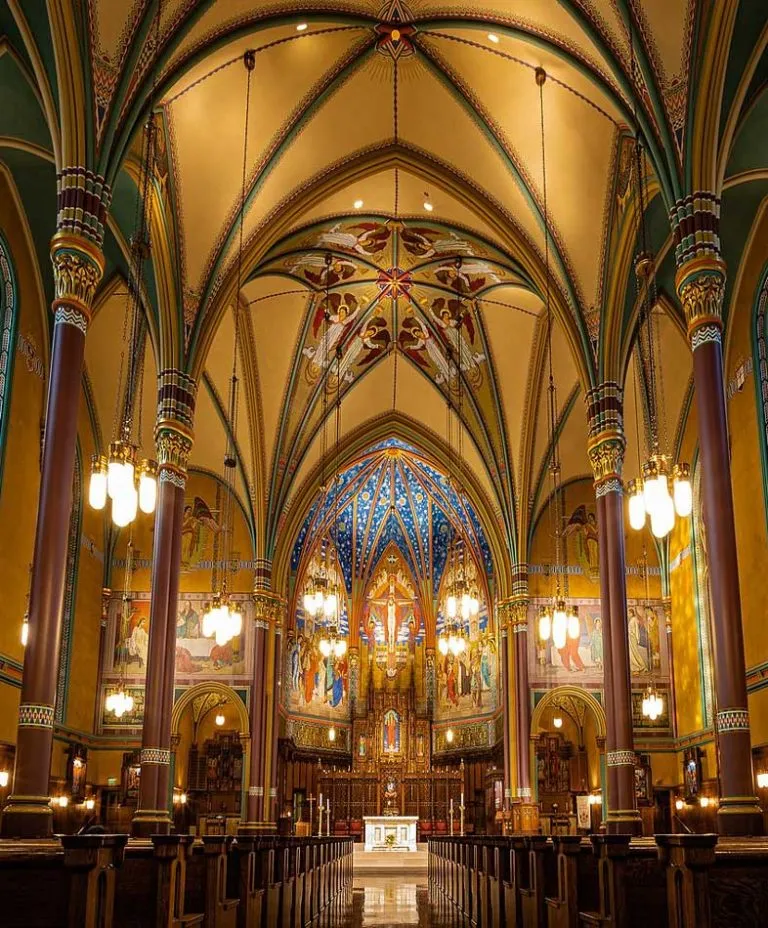
The Cathedral was built under the direction of Lawrence Scanlan, the first bishop of Salt Lake City, who dedicated it to St. Mary Magdalene. It was designed by architects Carl M. Neuhausen and Bernard O. Mecklenburg. The exterior is predominantly a Neo-Romanesque design, while the inside displays more Neo-Gothic details. Construction began in 1900 and was completed in 1909. It was dedicated by James Cardinal Gibbons, Archbishop of Baltimore.
The interior of the Cathedral was created under the direction of Joseph S. Glass, the second bishop of Salt Lake. Bishop Glass enlisted John Theodore Comes, one of the pre-eminent architects in the country, to decorate the interior of the cathedral. His plans for the interior were largely based upon the Spanish Gothic style. The colorful murals and polychrome were added at this time, as were the ornate shrines. In 1916, Bishop Glass also changed the name of the cathedral to the French spelling after visiting her purported tomb.
In the 1970s, the exterior of the building was restored, and between 1991 and 1993, the interior of the cathedral was renovated and restored under Bishop William K. Weigand. This included not only the removal of dust and dirt and restoration of the interior but also changes to the liturgical elements of the cathedral to bring them into conformity with certain wide spread changes in liturgical practice that developed after the Second Vatican Council.
This included constructing a new altar, moving the cathedra, creating a separate chapel for the Blessed Sacrament, and adding an ample baptismal font. The Blessed Sacrament Chapel also contains the tomb of Bishop Scanlan. Resting atop the tomb is a case containing a small relic of Saint Mary Magdalene.
The Cathedral in the Salt Lake City and the Basilica of Saint-Maximin-la-Sainte-Baume in France are the only cathedrals in the world holding first-class relics of the saint and are named in her honor. The major restoration of the interior of the cathedral was accomplished through the vision of Monsignor M. Francis Mannion.
The cathedral is home to the only co-educational Catholic Choir School in the United States. The Madeleine Choir School, established in 1996, now serves over 400 students in Pre-Kindergarten through Grade Eight. Composer Amédée Tremblay notably served as the church’s organist from 1920 to 1925.
Architecture

Architectural styles: Gothic Revival architecture, Romanesque Revival architecture.
Under the leadership of the Right Reverend Lawrence Scanlan (1843 – 1915), the first bishop of Salt Lake, the construction of The Cathedral of the Madeleine was begun in the year 1900 and completed in 1909. On August 15 of that year, the cathedral was dedicated by Cardinal James Gibbons of Baltimore. The architects were Carl M. Newhausen and Bernard O. Mecklenburg. The Cathedral combines a predominately Romanesque exterior with a Gothic interior. The property on which the Cathedral sits was purchased in 1890 for $35,000. The cost of the cathedral construction itself was $344,000.
The exterior of the Cathedral remains substantially the same today as it was in 1909, except for the addition of a tympanum over the main doors and the double flight of steps leading to the main entrance. Renovations on the exterior took place between 1975 and 1980 under the leadership of The Most Reverend Joseph Lennox Federal, sixth bishop of Salt Lake City. These including putting a new copper roof on the building, protecting the porous Utah sandstone from further erosion and replacing the gargoyles.
The interior of the Cathedral was largely created under the leadership of The Right Reverend Joseph S. Glass, who became Bishop of Salt Lake in 1915. A man of refined taste and strong artistic sensibility, Bishop Glass enlisted the aid of John Theodore Comes, one of the leading architects in America at the time, to undertake beautification of the original plain interior.
The Comes interior, begun in 1917, was inspired in great part by the Spanish Gothic of the late Middle Ages. The colorful murals were added at that time, as was the dramatic polychrome evident throughout the building. The ornate reredos shrine of Saint Mary Magdalene and the various shrines were notable features of the Comes renovation.
Under the leadership of The Most Reverend William K. Weigand, who was appointed bishop of Salt Lake City in 1980, a much needed restoration of the interior, which had suffered the effects of dirt and pollution in the intervening decades, was planned and executed. For this project, the services of the firm of Beyer Blinder Belle of New York were retained. This renovation and restoration, the most extensive in the Cathedral’s history, took place between 1991 and 1993 at a cost of $9.7 million and involved every aspect of the interior.
This included renovation of the liturgical elements of the Cathedral to bring them into conformity with the liturgical reforms that followed the Second Vatican Council (1962-1965), chiefly building a new altar in a more prominent location in the midst of the congregation; giving a new centrality to the bishop’s chair; providing a separate Blessed Sacrament chapel; and adding a more ample baptismal font.
Additional elements involved a seismic retrofit to strengthen the building against earthquake damage; the rebuilding of the lower level of the Cathedral, including Scanlan Hall; the creation of a new annex entrance to the Cathedral; and the construction of a plaza for the Cathedral.
The renewed building was formally rededicated on February 21, 1993. The Cathedral is listed on the Utah Register of Historic Sites and the National Register of Historic Places.
Altar
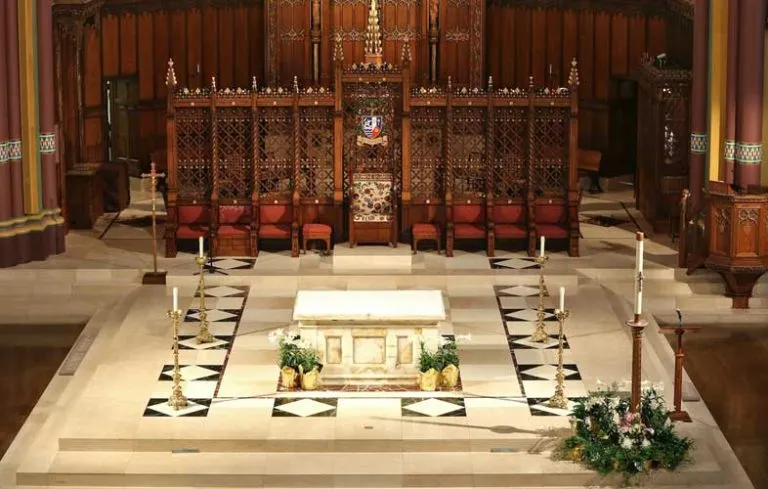
The altar, the central element in a Catholic church and the focal point of liturgical events, is built of Carrara onyx and inlaid with glass mosaic. It stands on a chancel (marble floor) designed to highlight and heighten its centrality and significance. The placement of the altar at the crossing marks its identity as the center and heart of the Cathedral. The centrality of the altar is further defined by four large chandeliers that hang in its vicinity.
These, along with the other chandeliers and light fixtures, were designed by Roger Morgan of New York and installed in 1993. The altar contains relics of St. Gratus, Bishop of Aosta in Piedmont, Northern Italy, who died in 457, and St Fenusta, an early Roman martyr buried in the Roman catacombs. The relics signify the call to sainthood of all who approach Christ’s table and the link across space and time between every eucharist The altar is visually related to the baptismal font, both in materials and style, symbolizing the close relationship between baptism and the Mass.
The Cathedral Choir
The Choir of the Cathedral of the Madeleine, consisting of adult members and choristers from The Madeleine Choir School, exists principally to serve the liturgical prayer of the cathedral church of the Diocese of Salt Lake City, established in 1909.
The choir sings a wide variety of liturgical music spanning every period in music history-from Gregorian chant to present day music. The choir takes seriously its duty of “preserving the sacred heritage of church music,” performing regularly works of Palestrina, Victoria, and Mozart.
The choir has been on three international tours that have encompassed performances in Rome, Assisi, Florence, Paris, Brussels, and Aachen-including St. Peter’s Basilica, and Notre Dame de Paris. The choir also broadcasts on radio and television, airing both concert and liturgical performances. They have three CD recordings available: Sing Joyfully, Let the Bright Seraphim, and O’ Great Mystery and Wondrous Sign.
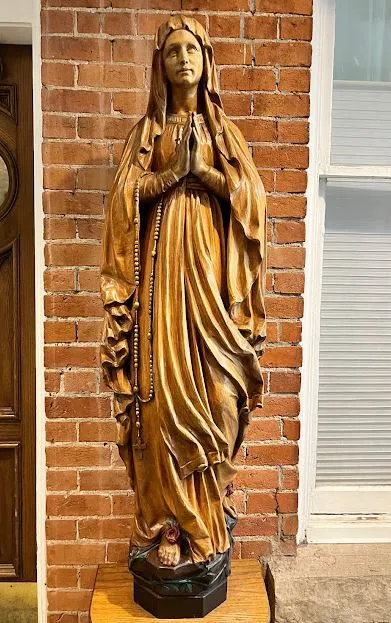
Cathedral Bells
The Cathedral Bells are rung and pealed to announce worship services and celebrate joyous occasions, or they are tolled to call mourners to prayer. Four bells, named after Saints Joseph, Mary, Cecilia and Michael, are housed in the west tower. Two original bells were cast at the Maryland Brass Foundry in 1917. The largest bell (Joseph) weighs 2,650 pounds and is tuned to the pitch E.
The second-largest bell (Mary) weighs 1,300 pounds and is tuned to the pitch A. Both of the original bells bear Latin inscriptions, the Mary bell reading in part “I praise the true God. I call the people. I do honor to feasts.” Two new bells, installed by the Verdin Company of Cincinnati in 1993 ring at pitch B (Cecilia) and pitch Cl! (Michael). The Cecilia bell’s inscription reads “Sing joyfully to the Lord, all the earth: ring out your joy.” The Michael bell reads “The time of earth will pass away, but not the time of heaven .”
Stations of the Cross
The fourteen Stations of the Cross were painted by Utah artist Roger (Sam) Wilson in 1992 and 1993. They replace a set of stations painted in 1918 which had since deteriorated badly. The new stations, starting at the northeast end of the building, begin with Jesus in the Garden of Olives and end with the burial of Christ. They generally follow a revised (and more biblical) version of the stations produced by the Vatican in 1975 and issued in various versions since then.
The stations combine elements of traditional iconography and American South-western coloration within a postmodern style. In developing each scene, the artist uses flowers, animals and various symbolic elements to draw out its meaning and significance. The frames of the stations were carved and installed in 1918 by William F. Ross and Company of East Cambridge, Massachusetts.
Dedication Cross
The Dedication Crosses mark the twelve places on which the walls of the Cathedral were anointed with Oil of Chrism at its dedication on February 21, 1993. The candles on the crosses are lighted each year on the anniversary of this dedication. The dedication crosses originate from the Cathedral’s earlier consecration in 1936.
Bishop's Chair
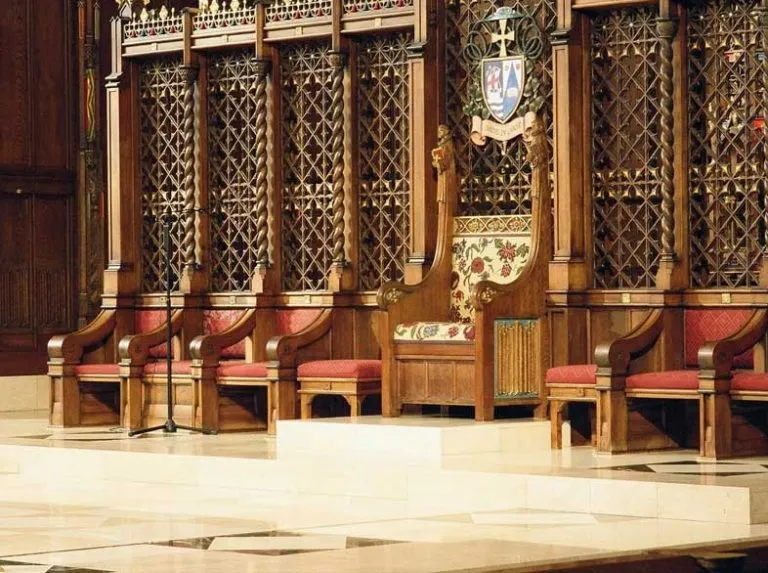
At the back of the chancel in front of the screen is the bishop’s chair or cathedral. This is the seat of the bishop and symbolizes his office presiding over the Diocese of Salt Lake City. Above the chairs the bishop’s coat of arms. To the right and left of the bishop’s chair are deacon stools and seating for concelebrating clergy. The presiding priest’s chair is second from the west end of the screen.
Blessed Sacrament Chapel and Tabernacle
‘The tabernacle tower, in which the Blessed Sacrament is reserved for the sick and for private veneration, stands in the middle of the Blessed Sacrament chapel behind the chancel screen, and is inspired by late medieval sacrament towers or sacrament houses. It’s the focal point of this chapel. ‘The brass tabernacle proper is in the shape of a building and is inspired by the design of the north end of the cathedral exterior.
At the north end of the Blessed Sacrament chapel is the tomb of the Right Reverend Lawrence Scanlan, the fist bishop of Salt Lake, under whose leadership the Cathedral was built. The tomb was adapted from the high altar used in the Cathedral from 1918-1965. Directly in the center of the chapel is the reliquary of St. Mary Magdalen, patroness of the Cathedral. The reliquary rests on the tomb of Bishop Scanlan.
Chancel Screen
The chancel area is divided from the Blessed Sacrament chapel by a chancel screen. Inspired by the medieval rood screen, it was made of hand-carved North American white oak by British master carvers Agrell and Thorpe Ltd. It reflects the general character of the 1918 woodwork in the cathedral, particularly the St. Mary Magdalen shrine at the north end.
Wood Carvings
Wood carvings in the Cathedral were completed by famous sculptors. The reredos are by Johann Kirchmayer, considered the best woodcarver in the United States. The linen folds on his carvings are a characteristic trademark of Kirchmayer. Above the main altar on each side of the picture of Mary Magdalene, the Kirchmayer statues represent founders of religious orders: on the east, Benedict, Clare and Dominic; and, on the west, Ignatius of Loyola, Terese of Avilla and Francis of Assisi.
Several sculptors in the same family worked on the Cathedral and one father and son pair regretted not having any place to leave their signature. So the father and son each took a block of wood and facing one another, carved the likeness of the other. They then affixed these two carvings to the sedilla (seat or bench for presiders at Mass), which now serves as the ambry (place of reservation for the holy oils). The carvings remain a fitting signature to the ingenuity and talent of these sculptors.
Murals in Sanctuary
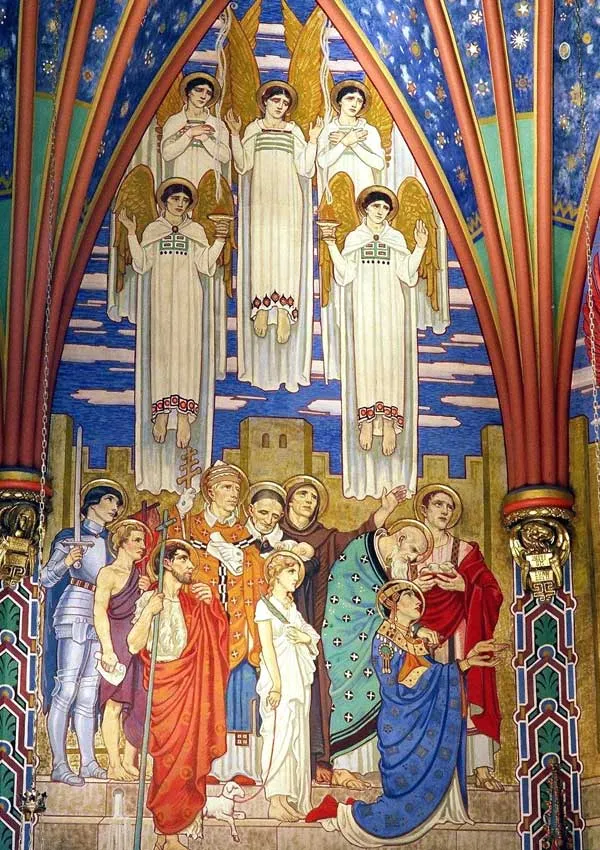
The murals at the front of the Cathedral were designed and painted by Felix Lieftuchter in 1918. They represent a combination of Byzantine, Spanish Gothic, and modern styles. At the center is the figure of Christ on the Cross, with God the Father and the Holy Spirit above. At the bottom of the Cross are a pelican and her children, symbolizing Christ’s sacrifice since the pelican feeds its young with its own blood.
The left mural depicts prominent Christian figures (St. Joan of Arc, St. Venatius, St. John the Baptist, St. Gregory, St. Vincent de Paul, St. Agnes, St. Pascal Baylon, St. Jerome. St. Helena, St. Stephen), and the right mural depicts Old Testament figures (Adam and Eve, Isaiah, Ester, Ruth, Melchizedek, Moses, David, St. Anne, Judith).
The crossing over the alar contains panels of angels, as do the upper regions of the vaulting throughout the Cathedral. The coats of arms of the eight bishops of the diocese are also found in the walls of the transepts.
The Striking blue and starred ceiling over the Blessed Sacrament chapel signifies the vault of heaven. Also painted by Felix Lieftuchter, it represents the influence of modern art on the artist’s work.
Gallery Organ

In 1909, a 27 rank electro-pneumatic organ was built and installed by the Kimball Company of Chicago. It was rebuilt by Schoenstein of San Francisco in 1953. By the mid 1980’s, this organ had come to the end of its natural life and was replaced in 1992 by a new vank mechanical action English-style organ built by Kenneth Jones and Associates of Bray, Ireland.
The organ, which has 4,066 pipes, stands in a Gothic case designed to match the woodwork installed in the Comes interior of 1918. A notable element of the organ is the Fanfare Trumpet that extends from the front of the choir gallery. The organ serves both liturgical and concert purposes.
Stained Glass Windows
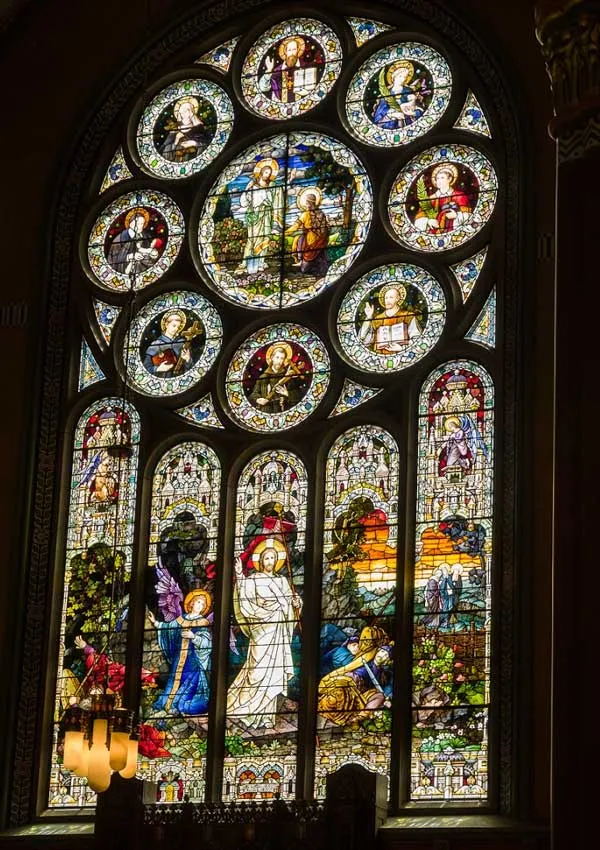
Originally designed by F. X. Zettler of the House of Littler, Royal Bavarian Institute in Munich, Germany, and installed in 1908, the windows in the body of the Cathedral were completely rebuilt in 1992 by Rohlf Studios of New York. The windows on the west side (from back to front) portray the Joyful Mysteries of the Rosary (The Annunciation, The Visitation, The Nativity, The Presentation of Jesus, and the Finding of the Child Jesus in the Temple).
The last of these is portrayed in the large west transept window, at the top of which is a scene of the woman, reputed to be St. Mary Magdalene, washing the feet of Jesus.
The windows on the east side (from front to back), beginning with the large east transept window, depict the Glorious Mysteries of the Rosary (The Resurrection, The Ascension, The Descent of the Holy Spirit, The Assumption of Mary, and The Crowning of Mary as Queen of Heaven). The Resurrection window also contains a medallion of Christ appearing to St. Mary Magdalene.
The two windows in the Blessed Sacrament chapel were designed by George W. Sotter of Pittsburgh in 1918 and display images of the twelve apostles. These windows exhibit a distinctly different style of stained glass from that in the body of the church. At the rear of the Cathedral above the organ is the great Rose Window depicting St. Cecilia, patroness of music, surrounded by angels with musical instruments.
Typanum
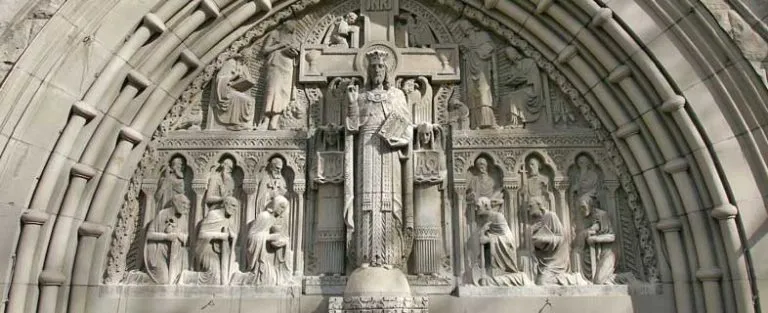
The result of seven years of labor, the tympanum above the main doors is the work of Francis Aretz of Pittsburgh, Pennsylvania. Shipped in several pieces to Sat Lake City in 1917, the tympanum features the figure of Christ as High Priest, lanked by an angel on each side; and the Twelve Apostles, six standing and six kneeling, each with his appropriate symbol.
The four great Doctors of the Church, Saints Jerome, Ambrose, Gregory and Augustine, appear in the upper half of the work. The four Evangelits, Saints Matthew, Mark, Luke and John appear surrounding the arms of the central cross.
Feast Day – 22nd July
Annual Feast Day of St. Mary Magdalene celebrated on 22nd July.
Mass Time
Weekdays
Saturdays
Sundays
Church Visiting Time
Contact Info
Cathedral of the Madeleine,
331 E. South Temple Street, Salt Lake City,
Utah, UT – 84111, United States
Phone No.
Tel : +1 801-328-8941
Accommodations
How to reach the Cathedral
Salt Lake City International Airport is located about 4 miles west of Downtown Salt Lake City, Utah, in the United States is the nearby airport to the Cathedral.
City Center Station is the Light rail station in Salt Lake City, Utah which is nearby to the Cathedral.

